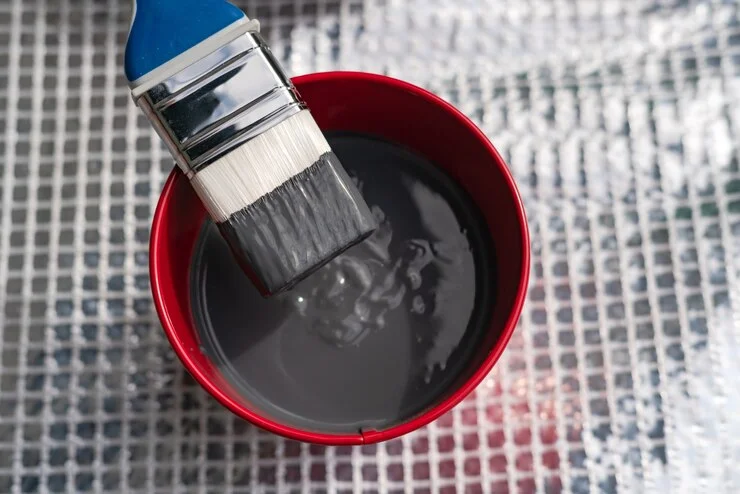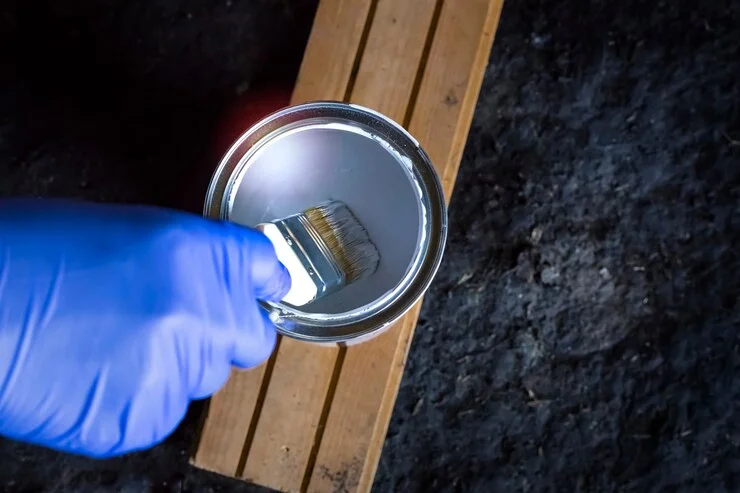A bathtub is an essential part of any bathroom, and keeping it clean and damage-free is important. Over time, chips, scratches, and discoloration can appear, making the tub look old and unattractive. Using touch-up paint for tubs offers a quick and cost-effective way to restore its original beauty.
Small imperfections in a bathtub can lead to bigger problems if left untreated for too long. Applying touch-up paint for tubs prevents further damage and keeps the surface looking new. This solution is affordable, easy to use, and works for most bathtub materials like enamel, fiberglass, and acrylic.
Types of Touch-Up Paint for Bathtubs

Enamel Touch-up Paint for Bathtub
Enamel touch-up paint is a popular choice for repairing bathtubs with enamel surfaces. It provides a durable and glossy finish that restores the tub’s original shine while protecting it from future damage. This type of paint covers small chips or scratches and blends seamlessly with the rest of the surface.
You can easily use enamel touch-up paint without professional tools or expertise. It dries quickly, allowing you to use your bathtub shortly after the repair. This product is ideal for those looking for a budget-friendly and effective solution for bathtub maintenance.
Choosing enamel touch-up paint ensures your bathtub stays clean, smooth, and free from visible imperfections. Its long-lasting finish adds years of life to your tub, making it a worthwhile investment. This paint benefits households with high bathtub usage, ensuring the surface remains protected.
Fiberglass Bathtub Touch-Up Paint
Fiberglass touch-up paint is specifically designed to repair bathtubs made from fiberglass materials. It offers a smooth and seamless finish that blends well with the tub’s original surface. This type of paint is perfect for covering cracks, chips, or minor dents in fiberglass tubs.
Applying fiberglass touch-up paint is straightforward and requires only basic tools, such as a brush or applicator. The paint resists water and other bathroom elements, ensuring the repairs last for a long time.
Homeowners prefer this option because it is easy to apply and delivers professional-looking results.
Using fiberglass touch-up paint can save you money compared to replacing the entire bathtub. It restores the tub’s appearance and prevents further damage, maintaining the quality of your bathroom. This paint works best for tubs in need of light to moderate repairs, offering a cost-effective solution.
Epoxy Touch-up Kit
Epoxy touch-up kits are perfect for long-lasting and highly durable bathtub repairs. These kits typically include paint and tools for application, making them easy for homeowners to use. Epoxy touch-up paint is water-resistant and ideal for areas that experience constant moisture.
This versatile paint works on multiple materials, including fiberglass, enamel, and porcelain surfaces. The strong adhesive properties of epoxy ensure the paint bonds securely, preventing cracks or chips from expanding further. Its durability makes it a great choice for high-traffic bathtubs in busy households.
Choosing an epoxy touch-up kit guarantees that your bathtub repair will stand the test of time. It offers a professional-grade finish that protects your tub from daily wear and tear. For those seeking a long-term solution, epoxy touch-up kits are highly recommended for all bathtub types.
Choosing the Best Touch-Up Paint for Tubs
When selecting the best touch-up paint for tubs, consider the tub material, color matching, and application method. Different materials, like fiberglass or enamel, require specific types of touch-up paints for effective results. Matching the paint color to your bathtub ensures a seamless repair that looks natural and clean.
Top-rated products are often labeled as the best touch-up paint for tubs because of their performance and durability. These paints provide long-lasting results, resist water damage, and blend well with existing surfaces. Many homeowners prefer these products for their ease of use and professional-grade finishes.
For color-specific needs, options like bathtub touch-up paint almonds are perfect for matching unique tub shades. These specialized paints help restore bathtubs to their original appearance without noticeable color differences. Choosing the right product ensures a flawless repair that enhances the overall look of your bathroom.
Application Methods and Tools
Using bathtub touch-up spray paint provides an easy and efficient way to cover imperfections evenly. Begin by cleaning the bathtub thoroughly to remove dirt, soap residue, or grease that could affect adhesion. Hold the spray cans about 8-12 inches away, and apply light, even coats to ensure smooth coverage without drips.
When working with rust-oleum tub and tile touch-ups, start by sanding the damaged area lightly to create a smooth surface. Use a damp cloth to clean the spot and let it dry completely before applying the paint. Apply the touch-up paint in thin layers, allowing each coat to dry as recommended on the product label.
For best results, always follow the manufacturer’s instructions and use proper ventilation while applying these products. Tools like painter’s tape can help protect surrounding areas from accidental paint splatters during the application. With patience and care, these methods can deliver professional-looking results for any type of bathtub repair.
Advantages of Using Touch-Up Paint
Touch-up paint offers a cost-effective solution compared to replacing an entire bathtub, saving time and money. Minor damage such as chips or scratches can be easily fixed without requiring professional assistance. This approach is budget-friendly and ideal for maintaining the longevity of your bathtub.
Using touch-up paint restores the aesthetic appeal of your bathtub by covering imperfections and discoloration effectively. Addressing damage early helps prevent further issues like cracks or leaks, which can be more expensive to fix. A well-maintained bathtub not only looks better but also increases the overall value of your bathroom.
The use of epoxy touch-up paint ensures extra durability, making it suitable for areas exposed to frequent moisture. Epoxy paint provides a strong and long-lasting bond, preventing damage from spreading over time. This durability makes it an excellent choice for households seeking reliable and long-term bathtub repair solutions.
Top Product Recommendations
Several excellent options are available when choosing the best bathtub touch-up paint for your needs. Products like rust-oleum tubs and tile touch-ups are widely recommended for minor chips and scratches. These paints are user-friendly, long-lasting, and deliver a seamless finish that blends well with the bathtub surface.
The epoxy touch-up kit stands out for its durability and suitability for high-moisture areas. It includes all the necessary tools for application and offers water resistance, making it perfect for long-term repairs. For households with heavy bathtub use, this kit is an excellent choice to maintain a flawless look.

For smaller and quick repairs, bathtub touch-up spray paint is a convenient option. It provides even coverage and is ideal for touch-ups on enamel, fiberglass, or porcelain tubs. Comparing these products helps users select the best option based on their bathtub’s material, damage level, and repair needs.
Maintenance Tips for Long-Lasting Results
Proper cleaning and protection are essential to maintain your tub after applying touch-up paint. Therefore, always clean the surface gently with a soft sponge or cloth to avoid scratching the repaired area. Additionally, avoid using abrasive cleaners, as they can damage the touch-up paint and reduce its effectiveness over time.
To keep the finish looking fresh, use mild cleaning products designed for bathtubs. Moreover, gentle, non-toxic cleaners help remove soap scum and dirt without harming the paint. Consequently, regular cleaning prevents buildup and keeps the tub’s surface smooth and shiny for longer periods.
Protect your tub by avoiding sharp objects or heavy impacts that can cause new chips or scratches. Consider using a bath mat to minimize wear and tear on high-traffic areas. Following these tips ensures that your bathtub stays in excellent condition for years to come.
Final Thought
Using touch-up paints for tubs is a convenient and cost-effective way to maintain your bathtub without the need for costly replacements. These products offer an easy solution for fixing chips, scratches, and discoloration, giving your tub a fresh, restored look. Whether you choose rust-oleum tub and tile touch-up or other top-rated options, the results are quick and effective.
Touch-up paints not only save money but also help protect your bathtub from further damage. By choosing the right product and applying it correctly, you can achieve professional results at home. For long-lasting repairs, consider reliable products like rust-oleum tubs and tile touch-ups, which are designed for excellent performance and durability.
Frequently Asked Questions (FAQs)
Q1: Can you touch up paint a bathtub?
Yes, you can touch up a bathtub with paint. It’s a great way to fix small chips and scratches. Make sure to use the right type of paint for your bathtub material.
Q2: Which paint is best for touch-ups?
The best paint for touch-ups is often enamel or epoxy paint. These types of paint are durable and work well on bathtubs. They help cover scratches and chips while blending in with the original surface.
Q3: What paint is used on tubs?
Paint made for bathtubs is usually enamel, epoxy, or specialized bathtub touch-up paint. These paints are designed to resist water and last for a long time. Make sure to choose the right one based on your tub’s material.
Q4: Will acrylic paint stick to a bathtub?
Acrylic paint may not stick well to a bathtub without proper preparation. The surface needs to be cleaned and primed first. It’s better to use paints specifically designed for bathtubs to get a long-lasting finish.
Q5: Can you repaint a tub that has already been painted?
Yes, you can repaint a tub that has already been painted. Just make sure to clean and lightly sand the surface before applying the new paint. This will help the new coat of paint stick better and last longer.
Q6: Does acrylic paint become waterproof?
Acrylic paint does not automatically become waterproof. However, it can become water-resistant when sealed properly. Using a clear waterproof sealant over acrylic paint helps protect it from water damage.
Q7: Is acrylic paint permanent or not?
Acrylic paint is permanent once it is dry and fully cured. It may fade or chip over time if not properly sealed. Applying a protective coat can help maintain its appearance longer.
Q8: What can I put on acrylic paint to make it waterproof?
To make acrylic paint waterproof, apply a clear waterproof sealant or varnish. This will protect the paint from water damage. Be sure to choose a sealant that is safe for use on painted surfaces.
Q9: Is acrylic paint washable?
Yes, acrylic paint is washable when it is still wet. Once it dries, it becomes more difficult to remove. For easy cleanup, wash acrylic paint off brushes and surfaces while it’s still wet.
Q10: Does acrylic paint expire?
Acrylic paint can expire over time. If the paint has dried out or separated, it may no longer work well. Always check the paint before use to make sure it’s still good.
Q11: Is finger paint the same as acrylic paint?
Finger paint is not the same as acrylic paint. Finger paint is usually thicker and designed to be safe for children to use. Acrylic paint is more durable and commonly used for arts and crafts.
Q12: What kind of paint is washable?
Washable paint is a type of paint that can be easily cleaned off with water. Many types of washable paint are safe for use on walls and surfaces that need frequent cleaning. Look for paints labeled “washable” when choosing for kids’ rooms or crafts.